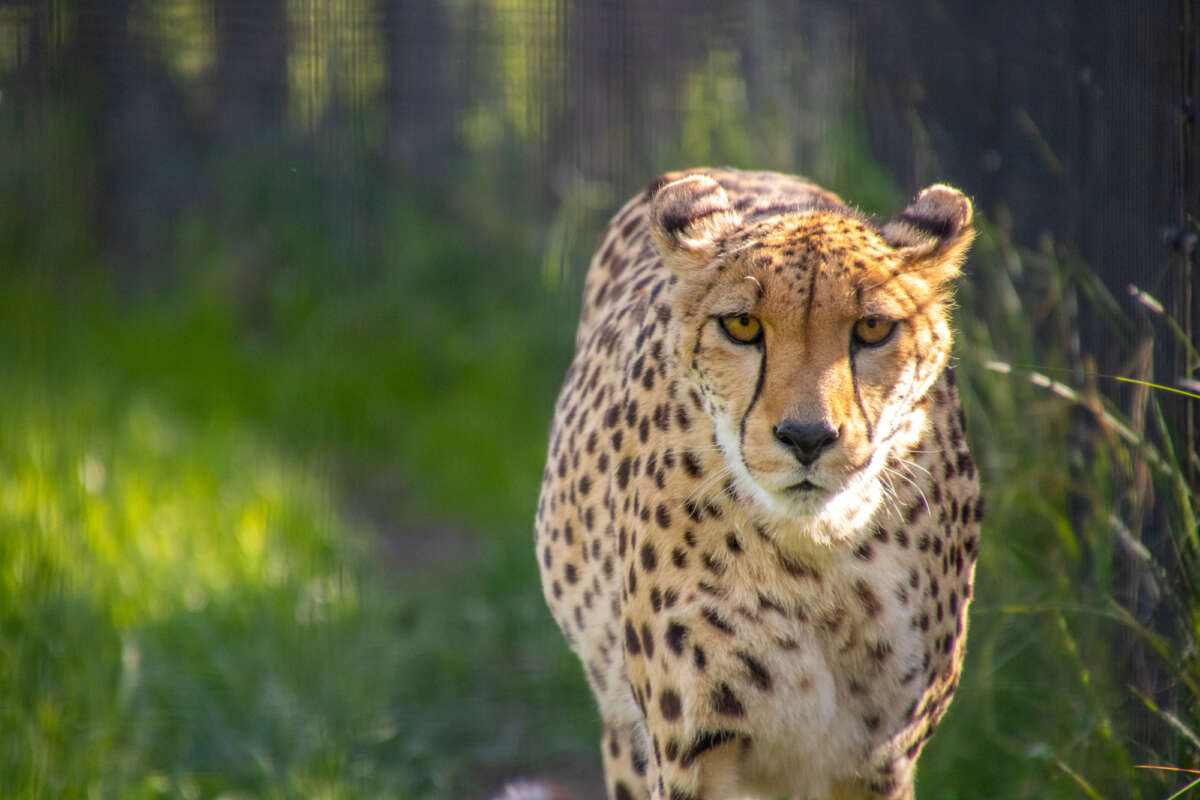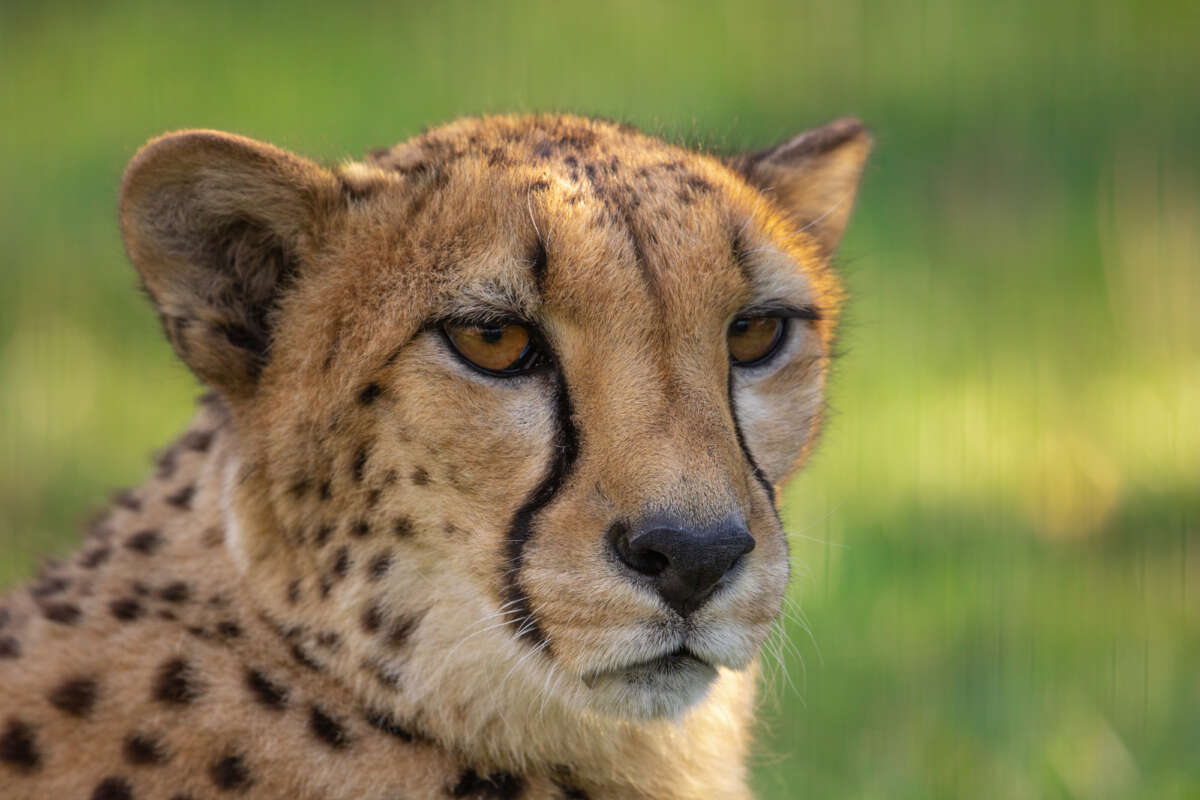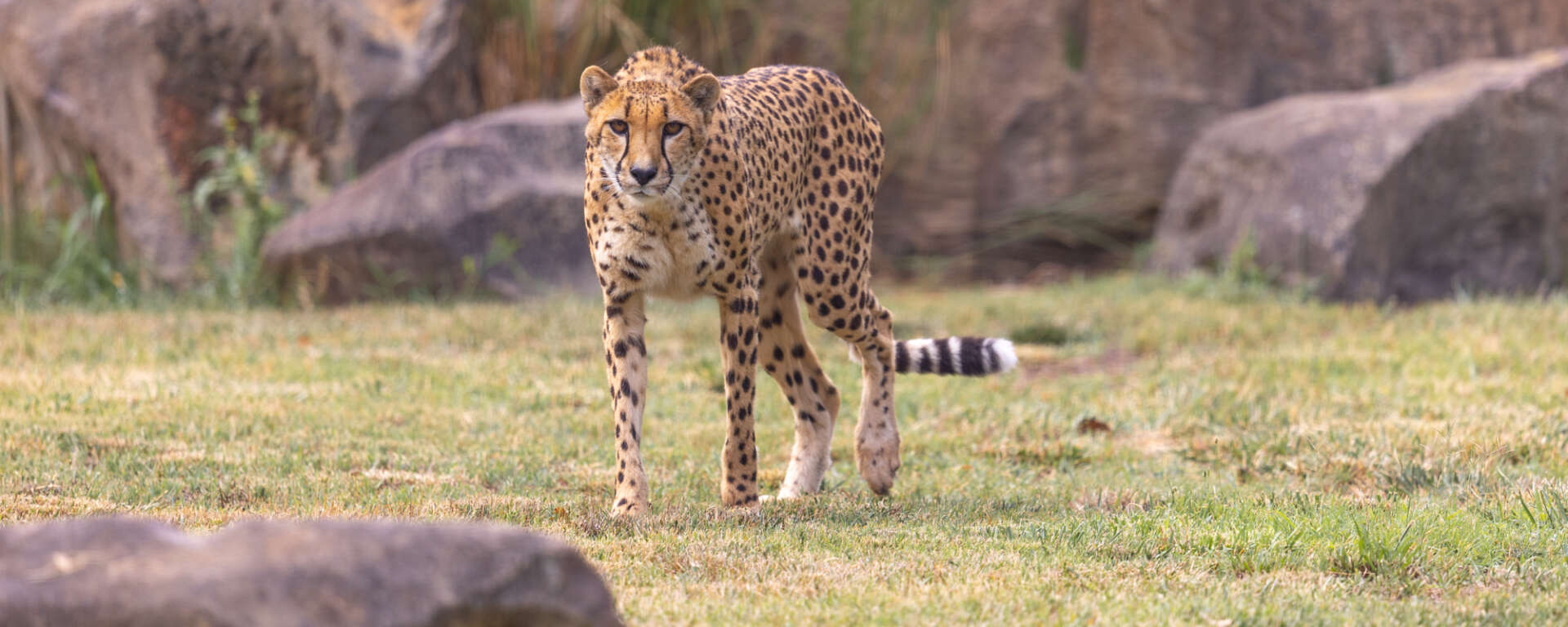Description
Cheetahs are specialists that are highly adapted for one thing: running fast! They have a slim torso that makes them more aerodynamic when running quickly. Animals with longer strides tend to be faster, and cheetahs have multiple adaptations to increase their stride length—long legs in relation to their total body size and an extremely flexible spine. Their long, flattened tail acts as a counterweight, enabling the cheetah to change direction quickly while chasing its prey. Semi-retractable claws act as cleats and add traction when running. Reduced canines may decrease bite strength, but allow for a larger nasal opening to increase the volume of air that the cheetah can bring in with each breath.
Cheetahs are sprinters, not endurance runners, and try to sneak as close as possible to their prey before starting a chase. Their coat helps with this: coarse, pale yellow fur speckled with black spots help them to camouflage in with their habitat. Cheetahs are diurnal, or daytime hunters so their “tear marks”, the black lines that run from the inner corner of the eye to the outer corner of the mouth, help reduce the glare from the sun.
Cover Photo: Adult female cheetah by Mark Pressler
Classification
- Overview
- Cheetahs are mammals in the felid, or cat family. They are the only living species within their genus Acinonyx. Recent genetic studies show that the cheetah's closest relatives in the cat family are the cougar and jaguarundi, both American species.
- Class
- Mammalia
- Order
- Carnivora
- Family
- Felidae
- Genus
- Acinonyx
- Species
- A. jubatus
Key Facts
- Conservation Status
- Vulnerable
- Lifespan
- 6 – 8 years in the wild; up to 17 – 19 years under human care
- Height
- 2.2 – 3 ft (~67 – 94 cm)
- Weight
- 86 – 140 lb (~40 – 63 kg)
The IUCN Red List describes the cheetah as a Vulnerable species. In 1900, it was estimated that there were approximately 100,000 cheetahs in the wild. Today, the population has declined to around 6,500 mature individuals. Genetic studies have shown that there is very little genetic variation within the species: only about 0.1 – 4% of the average genetic variation in living species. Evolutionary biologists believe that cheetahs underwent multiple severe population bottlenecks, which means cheetah numbers likely dropped very low multiple times in the last 10,000 – 100,000 years. The resulting low genetic variation increases the cheetah’s susceptibility to diseases, and decreases the amount of viable, robust offspring, both in the wild and under human care.
Other factors that threaten the cheetah’s survival include competition with other predators, persecution by humans, and habitat loss / fragmentation. Thankfully, there are excellent conservation organizations trying to conserve this unique cat. The Cheetah Conservation Fund, Cheetah Conservation Botswana and many others are conducting research to inform the best actions to take to help cheetahs, educating the public about the struggles cheetahs face, and actively conserving cheetahs with a variety of strategies. Livestock guard dog programs have successfully reduced cheetah-human conflict by providing livestock farmers with dogs that protect farmers’ herds and stop farmers from having to resort to killing a cheetah to protect their livelihood. Land conservancies are being formed, with landowners that are committed to managing their properties with a cheetah’s best interests in mind.
Modern conservation of animals often employs community-based conservation. The livelihood of wild animals is directly affected by the livelihood of the people living closest to those animals. People who don’t need to worry about food, water, shelter, clothing, sanitation, and healthcare are far more likely to have the time and energy to work towards protecting their local species. This means that any community and livelihood development program for people is also intrinsically a wildlife conservation program. A fantastic example of community-based conservation woven together with more traditional conservation is the Cheetah Conservation Fund’s Bushblok program. This program provides a framework for local businesses to remove invasive thorn brush plants, which are encroaching on cheetah habitat and making it more difficult for cheetahs to access their prey. This vegetation is then processed and turned into high-heat, low-emission biofuel logs and sold by these local businesses. So, this program helps cheetahs by improving their habitat while also helping local businesses to provide a green alternative to an essential product—a win for both wildlife and people.
Social Life
Female cheetahs are generally solitary animals except when raising their dependent young. Males are either solitary or in coalitions of 2 – 5 siblings and/or unrelated males. Males may be either territorial or nomadic. Territorial males mark the area that they defend with urine and feces and mate with females that enter their territory. Non-territorial males cover ground at a fast rate and are defined as nomads, often remaining in a single area for no more than a few days.
Habitat and Range
Cheetahs are primarily terrestrial, but have been known to scramble up trees on occasion. They inhabit grasslands, dry forest, savanna woodland, semi-desert and scrub habitats mostly in sub-Saharan Africa. There are pocketed populations in southern Algeria and northern Niger, and they range from Senegal east to Somalia and south to northern South Africa. A few have been reported from Iran. Many of their strongholds are in eastern and southern African parks. Historically cheetahs had a very wide range from Africa through the Arabian Peninsula and into India.
Diet
Cheetahs are carnivores that usually prey on small animals such as small antelope, hares, birds and warthogs. Males, working together in coalitions, can take down larger prey such as wildebeest and ostrich. Female cheetahs teach their young how to hunt by capturing and releasing live young antelope. Because cheetahs receive the majority of the moisture that they need from their prey, they can go for long periods of time without drinking water. In the Kalahari desert, cheetahs have been reported eating melons for their water content.
The cheetah is the fastest land mammal, capable of running up to 70 mph (112 kph). They can accelerate from 0 – 60 mph (96 kph) in about 3 seconds. They are sprinters, not long distance runners and can only sprint 600 – 1600 ft (200 – 500 m) before they are unable to continue. Typically, most of a cheetah’s chase doesn’t happen at these fast speeds, but closer to 30 mph (48 kph), with many sudden changes in direction. When cheetahs are able to overtake their prey, the animal is usually tripped using the cheetah’s forepaws. The majority of hunts end in failure and cheetahs in the Serengeti often lose their kills to lions and spotted hyenas.
Predators
Predators such as lions and hyenas will kill adult cheetahs if given the chance, but most adults will run away from predators. Cheetah cub mortality is very high and lions, hyenas and leopards have been documented killing cubs.
Reproduction
Sexual maturity: Male: 15 months, Female: 13 – 16 months
Mating Season: Females enter estrus at any time of year
Birth Season: Year-round
Gestation: 90 – 95 days
No. of Young: 1 – 6 per litter
- Information
-
Description
Cheetahs are specialists that are highly adapted for one thing: running fast! They have a slim torso that makes them more aerodynamic when running quickly. Animals with longer strides tend to be faster, and cheetahs have multiple adaptations to increase their stride length—long legs in relation to their total body size and an extremely flexible spine. Their long, flattened tail acts as a counterweight, enabling the cheetah to change direction quickly while chasing its prey. Semi-retractable claws act as cleats and add traction when running. Reduced canines may decrease bite strength, but allow for a larger nasal opening to increase the volume of air that the cheetah can bring in with each breath.
Cheetahs are sprinters, not endurance runners, and try to sneak as close as possible to their prey before starting a chase. Their coat helps with this: coarse, pale yellow fur speckled with black spots help them to camouflage in with their habitat. Cheetahs are diurnal, or daytime hunters so their “tear marks”, the black lines that run from the inner corner of the eye to the outer corner of the mouth, help reduce the glare from the sun.
Cover Photo: Adult female cheetah by Mark Pressler
Classification
- Overview
- Cheetahs are mammals in the felid, or cat family. They are the only living species within their genus Acinonyx. Recent genetic studies show that the cheetah's closest relatives in the cat family are the cougar and jaguarundi, both American species.
- Class
- Mammalia
- Order
- Carnivora
- Family
- Felidae
- Genus
- Acinonyx
- Species
- A. jubatus
Key Facts
- Conservation Status
- Vulnerable
- Lifespan
- 6 – 8 years in the wild; up to 17 – 19 years under human care
- Height
- 2.2 – 3 ft (~67 – 94 cm)
- Weight
- 86 – 140 lb (~40 – 63 kg)
- Conservation
The IUCN Red List describes the cheetah as a Vulnerable species. In 1900, it was estimated that there were approximately 100,000 cheetahs in the wild. Today, the population has declined to around 6,500 mature individuals. Genetic studies have shown that there is very little genetic variation within the species: only about 0.1 – 4% of the average genetic variation in living species. Evolutionary biologists believe that cheetahs underwent multiple severe population bottlenecks, which means cheetah numbers likely dropped very low multiple times in the last 10,000 – 100,000 years. The resulting low genetic variation increases the cheetah’s susceptibility to diseases, and decreases the amount of viable, robust offspring, both in the wild and under human care.
Other factors that threaten the cheetah’s survival include competition with other predators, persecution by humans, and habitat loss / fragmentation. Thankfully, there are excellent conservation organizations trying to conserve this unique cat. The Cheetah Conservation Fund, Cheetah Conservation Botswana and many others are conducting research to inform the best actions to take to help cheetahs, educating the public about the struggles cheetahs face, and actively conserving cheetahs with a variety of strategies. Livestock guard dog programs have successfully reduced cheetah-human conflict by providing livestock farmers with dogs that protect farmers’ herds and stop farmers from having to resort to killing a cheetah to protect their livelihood. Land conservancies are being formed, with landowners that are committed to managing their properties with a cheetah’s best interests in mind.
Modern conservation of animals often employs community-based conservation. The livelihood of wild animals is directly affected by the livelihood of the people living closest to those animals. People who don’t need to worry about food, water, shelter, clothing, sanitation, and healthcare are far more likely to have the time and energy to work towards protecting their local species. This means that any community and livelihood development program for people is also intrinsically a wildlife conservation program. A fantastic example of community-based conservation woven together with more traditional conservation is the Cheetah Conservation Fund’s Bushblok program. This program provides a framework for local businesses to remove invasive thorn brush plants, which are encroaching on cheetah habitat and making it more difficult for cheetahs to access their prey. This vegetation is then processed and turned into high-heat, low-emission biofuel logs and sold by these local businesses. So, this program helps cheetahs by improving their habitat while also helping local businesses to provide a green alternative to an essential product—a win for both wildlife and people.
- Lifestyle
Social Life
Female cheetahs are generally solitary animals except when raising their dependent young. Males are either solitary or in coalitions of 2 – 5 siblings and/or unrelated males. Males may be either territorial or nomadic. Territorial males mark the area that they defend with urine and feces and mate with females that enter their territory. Non-territorial males cover ground at a fast rate and are defined as nomads, often remaining in a single area for no more than a few days.
Habitat and Range
Cheetahs are primarily terrestrial, but have been known to scramble up trees on occasion. They inhabit grasslands, dry forest, savanna woodland, semi-desert and scrub habitats mostly in sub-Saharan Africa. There are pocketed populations in southern Algeria and northern Niger, and they range from Senegal east to Somalia and south to northern South Africa. A few have been reported from Iran. Many of their strongholds are in eastern and southern African parks. Historically cheetahs had a very wide range from Africa through the Arabian Peninsula and into India.
Diet
Cheetahs are carnivores that usually prey on small animals such as small antelope, hares, birds and warthogs. Males, working together in coalitions, can take down larger prey such as wildebeest and ostrich. Female cheetahs teach their young how to hunt by capturing and releasing live young antelope. Because cheetahs receive the majority of the moisture that they need from their prey, they can go for long periods of time without drinking water. In the Kalahari desert, cheetahs have been reported eating melons for their water content.
The cheetah is the fastest land mammal, capable of running up to 70 mph (112 kph). They can accelerate from 0 – 60 mph (96 kph) in about 3 seconds. They are sprinters, not long distance runners and can only sprint 600 – 1600 ft (200 – 500 m) before they are unable to continue. Typically, most of a cheetah’s chase doesn’t happen at these fast speeds, but closer to 30 mph (48 kph), with many sudden changes in direction. When cheetahs are able to overtake their prey, the animal is usually tripped using the cheetah’s forepaws. The majority of hunts end in failure and cheetahs in the Serengeti often lose their kills to lions and spotted hyenas.
Predators
Predators such as lions and hyenas will kill adult cheetahs if given the chance, but most adults will run away from predators. Cheetah cub mortality is very high and lions, hyenas and leopards have been documented killing cubs.
Reproduction
Sexual maturity: Male: 15 months, Female: 13 – 16 months
Mating Season: Females enter estrus at any time of year
Birth Season: Year-round
Gestation: 90 – 95 days
No. of Young: 1 – 6 per litter

Adult female cheetah by Mark Pressler

Adult female cheetah by Mark Pressler

